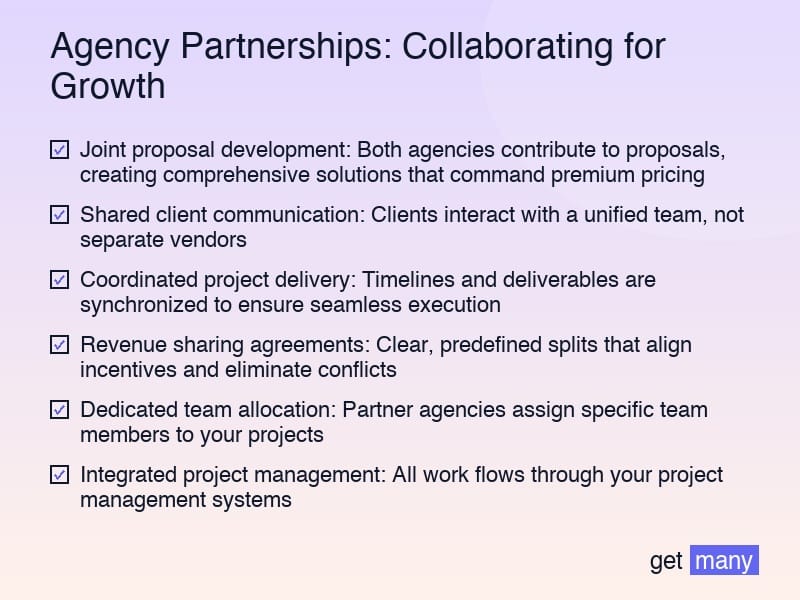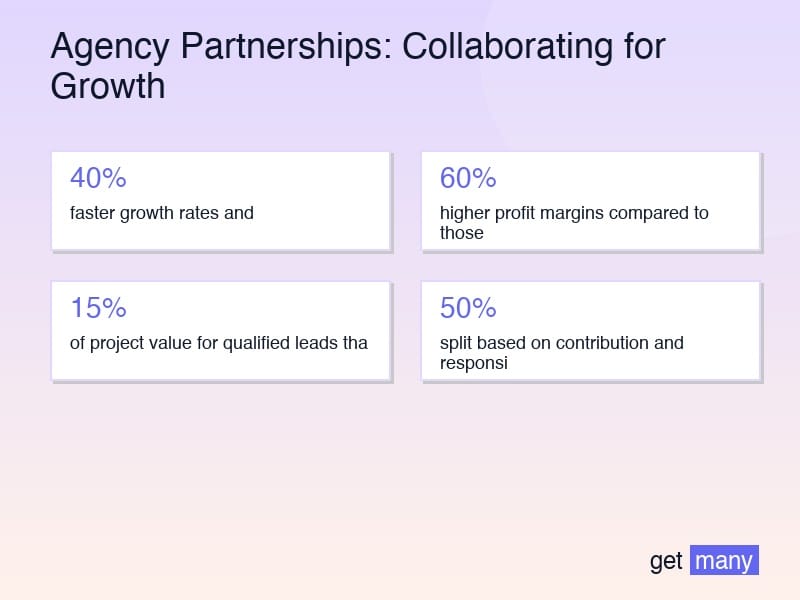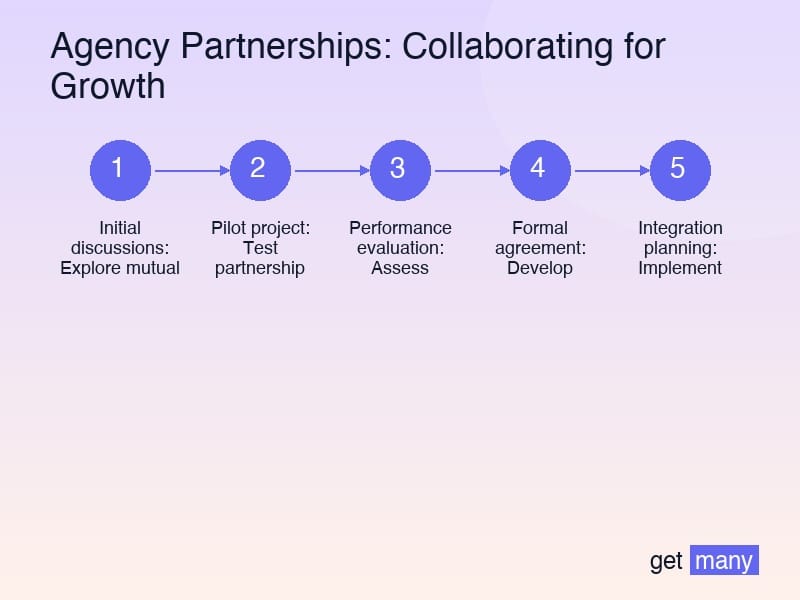Agency Partnerships: Collaborating for Growth
Strategic partnerships can multiply your agency's capacity, capabilities, and revenue streams. Learn how to build win-win collaborations that scale your business.

In the competitive landscape of Upwork agencies, the agencies that thrive aren't necessarily the ones working harder—they're the ones working smarter through strategic partnerships. While most agencies focus solely on internal growth, the most successful ones understand that collaboration can exponentially multiply their capacity, capabilities, and revenue streams.
After analyzing partnership structures across hundreds of successful agencies, one thing becomes clear: strategic partnerships aren't just nice-to-have relationships—they're essential growth engines that can transform your agency from a solo operation into a thriving business ecosystem.
The Hidden Power of Strategic Partnerships

Most agency owners approach partnerships backwards. They think partnerships are about finding someone to refer overflow work to, or getting referrals back. But the most successful agency partnerships operate on a completely different level—they create strategic advantages that would be impossible to achieve alone.
Consider this: A $500K agency partnering with complementary agencies can effectively operate with the capabilities of a $2M operation while maintaining the agility of a smaller business. This isn't theoretical—it's exactly what's happening in agencies that understand partnership dynamics.
The data supports this approach. Agencies with strategic partnerships report 40% faster growth rates and 60% higher profit margins compared to those operating in isolation. But here's what's interesting: these benefits compound over time, creating sustainable competitive advantages that become increasingly difficult for competitors to replicate.
Types of Strategic Partnerships That Drive Growth

Complementary Service Partnerships
The most straightforward partnerships involve agencies with complementary services. A web development agency partnering with a digital marketing agency, or a copywriting agency collaborating with a design firm. These partnerships work because they create complete solutions for clients while allowing each agency to focus on their core strengths.
But the key is structure. Successful complementary partnerships operate with clear protocols:
- Joint proposal development: Both agencies contribute to proposals, creating comprehensive solutions that command premium pricing
- Shared client communication: Clients interact with a unified team, not separate vendors
- Coordinated project delivery: Timelines and deliverables are synchronized to ensure seamless execution
- Revenue sharing agreements: Clear, predefined splits that align incentives and eliminate conflicts
Capacity Partnerships
These partnerships focus on expanding your agency's ability to handle larger projects or more clients without hiring full-time staff. Think of them as strategic outsourcing relationships, but with long-term commitments and integrated operations.
The most effective capacity partnerships involve:
- Dedicated team allocation: Partner agencies assign specific team members to your projects
- Integrated project management: All work flows through your project management systems
- Quality assurance protocols: Consistent standards across all delivered work
- Client invisibility: Clients see one cohesive team, not multiple vendors
Market Access Partnerships
These partnerships provide access to new markets, client segments, or geographic regions. They're particularly valuable for agencies looking to expand beyond their current client base or enter new verticals.
Successful market access partnerships typically involve:
- Local market expertise: Partners provide insights into regional business practices, cultural nuances, and market dynamics
- Established client relationships: Access to existing client networks and referral sources
- Industry-specific knowledge: Deep understanding of particular sectors or niches
- Regulatory compliance: Navigation of local business requirements and regulations
Building Win-Win Partnership Structures

The difference between partnerships that thrive and those that fail comes down to structure. Successful partnerships are built on clear frameworks that align incentives and create mutual value.
Revenue Sharing Models
The most straightforward model involves percentage-based revenue sharing:
- Lead generation partnerships: 10-15% of project value for qualified leads that convert
- Referral partnerships: 5-10% of first-year revenue for successful referrals
- Collaboration partnerships: 30-50% split based on contribution and responsibility
But percentage splits only work when contribution is clearly defined. The most successful partnerships use contribution-based models that account for:
- Business development effort: Who found the client and secured the project
- Project management responsibility: Who maintains client relationships and coordinates delivery
- Technical execution: Who performs the actual work and ensures quality
- Risk assumption: Who bears responsibility for project success and client satisfaction
Operational Integration
Successful partnerships require operational integration that goes beyond simple referrals:
- Shared project management systems: All partners use the same tools and workflows
- Unified communication protocols: Consistent client communication across all partners
- Standardized quality processes: Common standards for deliverables and client interaction
- Integrated reporting systems: Shared visibility into project progress and performance
Legal and Financial Frameworks
Partnership agreements should address:
- Scope and exclusivity: Clear definition of collaboration areas and competitive boundaries
- Intellectual property rights: Ownership of work products and methodologies
- Confidentiality requirements: Protection of client information and business practices
- Dispute resolution mechanisms: Clear processes for resolving conflicts and disagreements
Case Study: The $2M Partnership Network
One of the most successful partnership examples involves a network of five agencies that created a collaborative ecosystem generating over $2M in annual revenue. The structure demonstrates how strategic partnerships can create value beyond simple addition.
The Partnership Structure
The network consisted of:
- Core agency: Web development and technical implementation
- Creative partner: Design and branding services
- Marketing partner: Digital marketing and SEO
- Content partner: Copywriting and content strategy
- Strategy partner: Business consulting and planning
The Integration Model
Rather than operating as separate entities, the partners created an integrated service delivery model:
- Joint business development: All partners contributed to lead generation and proposal development
- Unified client experience: Clients worked with a single project manager across all services
- Shared quality standards: Common processes and deliverable standards across all partners
- Integrated pricing: Bundled pricing that provided value to clients while optimizing margins
The Results
The partnership network achieved:
- 40% higher project values: Comprehensive solutions commanded premium pricing
- 60% faster project delivery: Parallel execution across specialized teams
- 85% client retention rate: Complete solutions reduced client churn
- 300% revenue growth: Network effect multiplied individual agency performance
Technology That Enables Partnership Success
Modern partnerships require technology infrastructure that supports collaboration:
Project Management Integration
- Shared project visibility: All partners can see project status, timelines, and deliverables
- Unified communication: Centralized messaging and file sharing
- Integrated time tracking: Accurate billing and productivity measurement
- Automated reporting: Real-time performance data across all partners
Client Relationship Management
- Shared client databases: Complete client history accessible to all partners
- Integrated lead tracking: Visibility into lead sources and conversion paths
- Unified billing systems: Simplified invoicing and payment processing
- Automated follow-up: Consistent client communication and relationship maintenance
Quality Assurance Systems
- Standardized workflows: Common processes across all partners
- Automated quality checks: Consistent standards enforcement
- Performance monitoring: Real-time tracking of delivery quality and client satisfaction
- Continuous improvement: Data-driven optimization of partnership performance
Partnership Development Strategy
Building successful partnerships requires a systematic approach:
Partner Identification
Look for agencies that:
- Serve similar clients: Overlapping client bases create collaboration opportunities
- Offer complementary services: Services that enhance rather than compete with your offerings
- Share similar values: Compatible business philosophies and client service standards
- Have proven track records: Demonstrated ability to deliver quality work consistently
Partnership Evaluation
Assess potential partners based on:
- Financial stability: Ability to invest in partnership development and maintain commitments
- Operational capacity: Resources to handle additional work without compromising quality
- Cultural fit: Compatible communication styles and business practices
- Growth trajectory: Alignment of growth goals and timeline expectations
Partnership Development Process
- Initial discussions: Explore mutual interests and potential collaboration areas
- Pilot project: Test partnership dynamics with a small, low-risk project
- Performance evaluation: Assess collaboration effectiveness and identify improvement areas
- Formal agreement: Develop comprehensive partnership terms and operational protocols
- Integration planning: Implement systems and processes for ongoing collaboration
- Performance monitoring: Regular review and optimization of partnership performance
How Getmany Supports Partnership Success
Partnership success depends on operational efficiency and client acquisition capability. Getmany provides the infrastructure that enables agencies to focus on partnership development while maintaining competitive advantages:
Automated Lead Generation
- Continuous proposal flow: Consistent opportunities for partnership collaboration
- Quality lead filtering: Pre-qualified prospects that match partnership capabilities
- Competitive intelligence: Market insights that inform partnership strategy
- Performance optimization: Data-driven improvements to partnership effectiveness
Operational Efficiency
- Streamlined workflows: Standardized processes that support partnership integration
- Automated reporting: Performance data that enables partnership optimization
- Resource allocation: Tools that help manage partnership workload and capacity
- Quality assurance: Systems that maintain standards across partnership networks
Building Long-Term Partnership Value
The most successful partnerships evolve beyond transactional relationships into strategic alliances:
Joint Marketing Initiatives
- Co-branded content: Shared thought leadership and expertise demonstration
- Joint webinars: Collaborative education and lead generation efforts
- Shared case studies: Combined success stories that highlight partnership value
- Cross-promotion: Mutual marketing support and audience sharing
Shared Technology Development
- Custom tools: Jointly developed solutions that create competitive advantages
- Integrated systems: Technology platforms that support seamless collaboration
- Shared resources: Common infrastructure that reduces individual costs
- Innovation partnerships: Collaborative development of new service offerings
Market Expansion
- Geographic growth: Access to new markets through partner networks
- Vertical expansion: Entry into new industries through partner expertise
- Service diversification: New offerings created through partnership capabilities
- Client base growth: Expanded market reach through partner relationships
Key Takeaways for Partnership Success
- Strategic focus: Partnerships should align with long-term business objectives, not just short-term revenue needs
- Operational integration: Successful partnerships require systems and processes that support seamless collaboration
- Clear agreements: Formal structures that define roles, responsibilities, and revenue sharing
- Technology infrastructure: Systems that enable effective partnership management and client service
- Performance measurement: Regular evaluation and optimization of partnership effectiveness
Strategic partnerships represent one of the most powerful growth strategies available to Upwork agencies. They provide access to capabilities, markets, and resources that would be impossible to develop independently, while creating sustainable competitive advantages that compound over time.
The agencies that master partnership development will find themselves with exponentially greater capacity, capability, and market reach—all while maintaining the agility and focus that make agencies successful. In an increasingly competitive marketplace, partnerships aren't just growth opportunities—they're essential business strategies that separate thriving agencies from struggling ones.
Ready to build partnership networks that multiply your agency's growth potential? Getmany provides the operational foundation that enables partnership success, with automated systems that handle lead generation, project management, and performance optimization while you focus on building strategic relationships that drive exponential growth.





